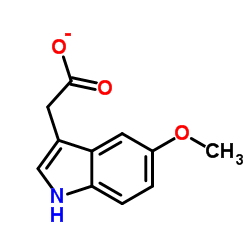

5-甲氧基吲哚-3-乙酸结构式

|
常用名 | 5-甲氧基吲哚-3-乙酸 | 英文名 | 5-Methoxyindole-3-acetic acid |
|---|---|---|---|---|
| CAS号 | 3471-31-6 | 分子量 | 205.21000 | |
| 密度 | N/A | 沸点 | 445.9ºC at 760 mmHg | |
| 分子式 | C11H11NO3 | 熔点 | 145-148 °C (dec.)(lit.) | |
| MSDS | 中文版 美版 | 闪点 | 223.5ºC |
|
Indoleamines and 5-methoxyindoles in trout pineal organ in vivo: daily changes and influence of photoperiod.
Gen. Comp. Endocrinol. 144(1) , 67-77, (2005) This study describes the diel rhythms in several indoleamines, melatonin, and related 5-methoxyindoles in the pineal organ of rainbow trout in vivo. In addition, the effect of different photoperiod conditions was evaluated. Melatonin levels displayed clear da... |
|
|
Total pineal endocrine substitution therapy (TPEST) as a new neuroendocrine palliative treatment of untreatable metastatic solid tumor patients: a phase II study.
Neuro Endocrinol. Lett. 24(3-4) , 259-62, (2003) It is known since many years that the pineal gland plays an anticancer role, and melatonin (MLT), the most investigated pineal hormone, has been proven to exert antitumor activity. However, MLT would not be the only hormone responsible for the antitumor actio... |
|
|
Secretion of the methoxyindoles melatonin, 5-methoxytryptophol, 5-methoxyindoleacetic acid, and 5-methoxytryptamine from trout pineal organs in superfusion culture: effects of light intensity.
Gen. Comp. Endocrinol. 101(2) , 165-72, (1996) The teleost pineal organ is a photoreceptive endocrine organ that synthesizes the hormone melatonin through specialized intrapineal photoreceptor cells in a light-dependent manner. The present study investigated whether the methoxyindoles 5-methoxytryptophol ... |
|
|
Photoperiod affects amplitude but not duration of in vitro melatonin production in the ruin lizard (Podarcis sicula).
J. Biol. Rhythms 18(1) , 63-70, (2003) The pineal gland and its major output signal melatonin have been demonstrated to play a central role in the seasonal organization of the ruin lizard Podarcis sicula. Seasonal variations in the amplitude of the nocturnal melatonin signal, with high values in s... |
|
|
Binding of ring-substituted indole-3-acetic acids to human serum albumin.
Bioorg. Med. Chem. 15 , 4595-600, (2007) The plant hormone, indole-3-acetic acid (IAA), and its ring-substituted derivatives have recently attracted attention as promising pro-drugs in cancer therapy. Here we present relative binding constants to human serum albumin for IAA and 34 of its derivatives... |
|
|
[Excretion of 5-hydroxyindole-3-acetic and 5-methoxyindole-3-acetic acids in cancer patients].
Vopr. Onkol. 33(10) , 20-5, (1987) Daily urinary excretion of 5-hydroxy-3-indoleacetic acid (5-HIAA) and 5-methoxyindole-3-acetic acid (5-MIAA) was studied by chromatography-mass-spectrometry in patients with cancer and healthy subjects. A considerable increase in urinary 5-MIAA-excretion was ... |
|
|
Melatonin deacetylase activity in the pineal gland and brain of the lizards Anolis carolinensis and Sceloporus jarrovi.
Neuroscience 62(2) , 615-23, (1994) Melatonin modulates a variety of rhythmic processes in vertebrates, and is synthesized in both the retina and pineal gland. We have shown previously that retinal melatonin is deacetylated generating 5-methoxytryptamine, which is then deaminated by monoamine o... |
|
|
Secretion of methoxyindoles from trout pineal organs in vitro: indication for a paracrine melatonin feedback.
Neurochem. Int. 27(2) , 195-200, (1995) Synthesis and release of the pineal hormone melatonin is in all vertebrates primarily regulated by the light/dark cycle. In pineal organs of teleost fish, like in other non-mammalian vertebrates, melatonin formation is regulated by a direct photoreception of ... |
|
|
Effect of light on 5-methoxyindole-3-acetic acid in the rat.
J. Neural Transm. Gen. Sect. 108(5) , 503-11, (2001) This study aims to determine the effects of light on the levels of 5-MIAA to provide further information on this indoleamine, using a sensitive and specific radioimmunoassay (RIA) for immunoreactive 5-methoxyindole-3-acetic acid (5-MIAA) developed in our labo... |
|
|
Effect of a pineal indolamine, 5-methoxyindole-3-acetic acid, on the estrous cycle and reproductive organs of female Wistar albino rats.
Brain Res. 493(1) , 1-7, (1989) It has been suggested that the pineal gland has a specific role in the control of cyclic sexual activity in rats. One or more of the compounds isolated from this gland have been considered to be possible anti-fertility agents. In this study, the effect of dif... |